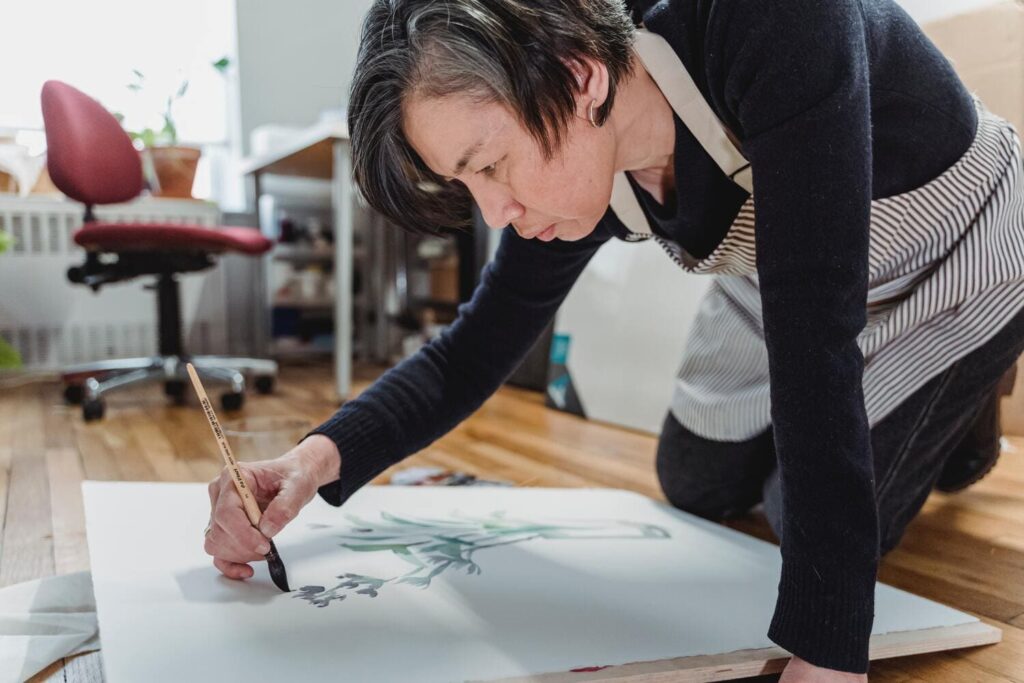Can you put a price on creativity and vision? Is technical skill the only quantifiable value? These are common questions that arise when pricing an artwork. The truth is there is no work-for-all formula. Many factors come into play: from qualifications and experience to materials and related services fees.
How should you approach pricing your artwork? Keep reading to find different approaches and learn how to come up with your own pricing formula that is aligned with your sales or commissions goals, and the overall objective of making a living out of your artistic endeavors and growing your art business.

Contents
What to take into account when pricing your art pieces
-Your medium of choice
-Size of the piece
-Technique and overall skills
-Hours of work invested
–Tools and materials
-Subject matter
-Experience: exhibitions, art fair presence, and any type of recognition like grants, residencies, and awards.
-Price of previously sold pieces
-Related expenses: promotion, art marketing efforts, etc.
-Target market: from niches to a general audience.Related fees: professional representation and gallerist or gallery fees.

Essential advice to price your art
Pricing is not only the action of setting a value number on an art piece. This action has a lot to do with your art business goal, recognizing your work and experience, and providing yourself with an income that says “my creativity can sustain my projects and me”.
Make sure to follow these art world insights when pricing your art pieces:
-Give a monetary value to each hour of your work.
-Do some market research: look at similar art piece prices from artists that have the same trajectory or work with the same medium, size, or subject.
-When it comes to commissions: make a contractual agreement and make sure to ask for a deposit. 30% to 50% are common requests from artists in order to begin working on a costume piece.
-If you sell through galleries make sure to add their commission fee to the final price of the piece. This way you’ll avoid deducting it from your final earnings.
-Keep a record of your sales so you can track price variations over time.
-Is it on demand? Is your particular work, subject, or medium trending? This is the market value and will add to the final price of a piece. What type of artwork are you pricing? Is it a unique piece, an art print, a reproduction, something customized, or a part of a more extensive series? Uniqueness tends to raise the price of the piece.

How to price your artworks: approaches and steps to follow
Here comes the moment you’ve waited for: putting a monetary price that represents the hard work, the skills, the creative process, and the time put into a piece. As mentioned before, there is not one approach to how to price what you do, but we are here to share specific tactics on how to take upon this task and come up with your own way to price your artwork, one that suits your particular needs.
Pricing by hour
An artist’s hour of work has a particular value, just like any other worker. You can establish a general hourly wage for your work. Then the price of any artwork will be determined by the number of hours invested in its creation. Of course, to this amount, you will also add the cost of materials and even framing.
Pricing by inch
Other artists take this path when it comes to pricing. You can approach it in two different ways: giving a precise value to each inch, then adding up the length plus the size of the piece to reach its production value. This formula will look like this:
Length + Width x price per inch = basic price.
Another way to do it it’s pricing by the square inch, which implies multiplying the width, by the length, and then this number by the price per square inch. In both cases, you have to add in the end the cost of materials, and market value around your signature and creations.
This pricing formula looks like this:
Length X Width = # of Square inches of the piece
Number of Square inches of the piece X Price per square inch = basic price.
Check this exclusive ArtPlacer Academy article “How to price your art for profit and growth: the ultimate guide”. Take the lesson by logging into your ArtPlacer account or starting your free trial.

Art pricing: how to reach your sales and commission goals
Pricing is just one of the elements of a bigger picture: your art business plan. The income that flows from sales and commissions is the one that not only makes your business profitable but sustainable.
A social media content strategy that showcases your art to a bigger audience or creating a 3D virtual gallery to give collectors the chance to interact with your creations are just some of the common art marketing strategy pushes that will take a visitor through the journey of learning about your work, getting interested in it, inquiring and making the desired purchase.
ArtPlacer has developed art marketing tools to support you on each step of the way. Our Website Integrations ease the shopping process for the collector, providing them with a frictionless experience. You can even provide visitors with Augment Reality previews through our widget, something that helps reduce buyers’ doubt and push them through a final sale.
Our Analytics feature gives you valuable insights about how users interact with your 3D digital galleries and widgets, providing you with information that can help you make more informed decisions when it comes to pricing: from what artworks the visitors are more interested in, to who shapes your audience.
Now that you know the basics of art pricing: get working and start creating your own formula that will make your art business thrive.



